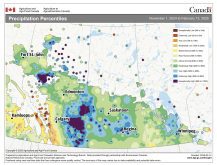This cattle market information is selected from the weekly report from Canfax, a division of the Canadian Cattlemen’s Association. More market information, analysis and statistics are available by becoming a Canfax subscriber by calling 403-275-5110 or at www.canfax.ca.
Strong fed prices
Fed prices averaged more than $164 per hundredweight, and other than in 2015, it was the second strongest weekly price in history for the middle of June. Feedlots are the most current they’ve been in some time, and in some cases cattle intended for the August market are being sold now.
Read Also

Huge Black Sea flax crop to provide stiff competition
Russia and Kazakhstan harvested huge flax crops and will be providing stiff competition in China and the EU.
Last week dressed sales ranged from $274-$277 per cwt. delivered. Most of the cattle that traded were being scheduled for delivery the week of July 12. Dressed bids for the second half of July delivery were reported a couple dollars lower compared to mid-July delivery cattle.
Premiums were noted last week on export eligible cattle that have not been fed ractopamine.
Historically, when western Canadian fed prices are at such a premium to the U.S. market, Canadian packers usually scale back hours. This has not been the case because processing margins are still positive and instead of reducing hours, there has been talk of adding a few Saturday shifts in coming weeks.
In Ontario, dressed sales were reported from $270-$272 per cwt. delivered, steady to $2 per cwt. higher than the previous week. Eastern Canadian steer carcass weights averaged 947 pounds, 43 lb. larger than last year. Some big cattle are being sold through commercial auction facilities to avoid weight discounts.
Canadian beef exports continue positive. From January to April, Canadian beef exports are 23 percent higher in volume and 27 percent in value.
In the United States, dressed sales in the north were reported from US$193-$200 per cwt. with most at $195 per cwt., and live sales were at mostly $124 per cwt. Dressed deals were $4-$5 per cwt. higher than the previous week, while live sales were $3-$4 per cwt. stronger.
Non-fed prices surge
Slaughter cows traded mixed on ample offerings last week. Large fleshy D2 cows saw prices modestly higher while D3 cows averaged almost $1 per cwt. lower than the previous week. In Alberta, D2s averaged $103.13 and D3s averaged $89 per cwt.
Non-fed prices continue to surge to new annual highs, and last week D2 cow prices were the strongest since July 2017. Dressed cow bids firmed $1-$2 per cwt. higher last week, ranging from around $195-$200 per cwt. delivered.
Alberta slaughter cow prices last week were the strongest in North America, trading at significant premiums to Ontario and the U.S. utility cow market. Butcher bulls saw prices $2.43 per cwt. higher than the previous week to a new annual high of $116.96 per cwt.
Western Canadian non-fed slaughter for the week ending June 12 was two percent larger than the previous week at 7,348 head and year to date was up five percent to 159,298 head.
Good feeder demand
Good demand continued for all types of feeders last week, and prices firmed around $1 per cwt. higher. Calves from 500-700 lb. traded unevenly steady last week and 700-800 lb. feeders traded mixed with steers surging $5 per cwt. higher while similar weight heifers dipped $1 per cwt. lower. Large feeders heavier than 800 lb. also traded mixed with steers firming $1-$1.50 per cwt. higher and heifers steady to lower.
Softer feedgrain prices and improved feeding margins were supportive last week, but moisture concerns are increasingly limiting grass interest. Calves from 600-700 lb. for deferred October delivery have been reported steady to $5 per cwt. higher than prices seen two weeks ago.
Auction volumes were 10 percent lower than the previous week at 13,925 head and 32 percent lower than the same week last year. Year-to-date auction volumes were 16 percent larger than a year ago at 559,125 head.
Canadian feeder exports to the U.S. for the week ending June 5 were modestly lower than the previous week and year to date were 42 percent lower than last year at 40,551 head. Feeder exports to the U.S. are expected to tighten through the rest of June and into July.
U.S. cutouts slide
In U.S. beef trade, cut-out values slipped seasonally lower last week on softer middle meat and brisket demand. Choice averaged US$326.25 per cwt., down $12 per cwt., and Select averaged $287.24, down sharply by $23 per cwt. Total U.S. slaughter was mostly steady with the previous week at 663,000 head.
















